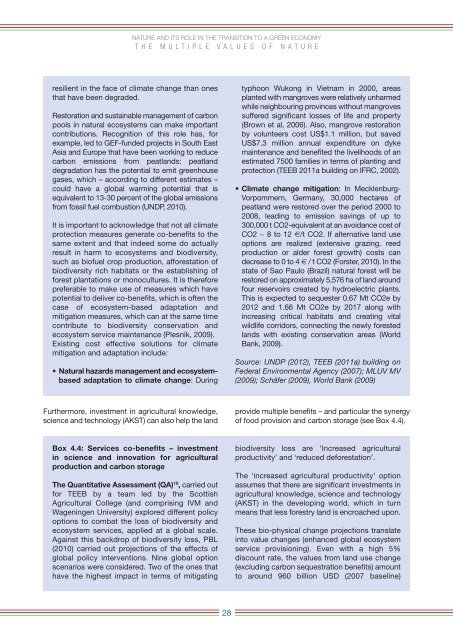Green-Economy-Report
Green-Economy-Report
Green-Economy-Report
You also want an ePaper? Increase the reach of your titles
YUMPU automatically turns print PDFs into web optimized ePapers that Google loves.
NATURE AND ITS ROLE IN THE TRANSITION TO A GREEN ECONOMY<br />
T H E M U L T I P L E V A L U E S O F N A T U R E<br />
resilient in the face of climate change than ones<br />
that have been degraded.<br />
Restoration and sustainable management of carbon<br />
pools in natural ecosystems can make important<br />
contributions. Recognition of this role has, for<br />
example, led to GEF-funded projects in South East<br />
Asia and Europe that have been working to reduce<br />
carbon emissions from peatlands: peatland<br />
degradation has the potential to emit greenhouse<br />
gases, which – according to different estimates –<br />
could have a global warming potential that is<br />
equivalent to 13-30 percent of the global emissions<br />
from fossil fuel combustion (UNDP, 2010).<br />
It is important to acknowledge that not all climate<br />
protection measures generate co-benefits to the<br />
same extent and that indeed some do actually<br />
result in harm to ecosystems and biodiversity,<br />
such as biofuel crop production, afforestation of<br />
biodiversity rich habitats or the establishing of<br />
forest plantations or monocultures. It is therefore<br />
preferable to make use of measures which have<br />
potential to deliver co-benefits, which is often the<br />
case of ecosystem-based adaptation and<br />
mitigation measures, which can at the same time<br />
contribute to biodiversity conservation and<br />
ecosystem service maintenance (Plesník, 2009).<br />
Existing cost effective solutions for climate<br />
mitigation and adaptation include:<br />
• Natural hazards management and ecosystembased<br />
adaptation to climate change: During<br />
Furthermore, investment in agricultural knowledge,<br />
science and technology (AKST) can also help the land<br />
Box 4.4: Services co-benefits – investment<br />
in science and innovation for agricultural<br />
production and carbon storage<br />
The Quantitative Assessment (QA) 10 , carried out<br />
for TEEB by a team led by the Scottish<br />
Agricultural College (and comprising IVM and<br />
Wageningen University) explored different policy<br />
options to combat the loss of biodiversity and<br />
ecosystem services, applied at a global scale.<br />
Against this backdrop of biodiversity loss, PBL<br />
(2010) carried out projections of the effects of<br />
global policy interventions. Nine global option<br />
scenarios were considered. Two of the ones that<br />
have the highest impact in terms of mitigating<br />
28<br />
typhoon Wukong in Vietnam in 2000, areas<br />
planted with mangroves were relatively unharmed<br />
while neighbouring provinces without mangroves<br />
suffered significant losses of life and property<br />
(Brown et al, 2006). Also, mangrove restoration<br />
by volunteers cost US$1.1 million, but saved<br />
US$7.3 million annual expenditure on dyke<br />
maintenance and benefited the livelihoods of an<br />
estimated 7500 families in terms of planting and<br />
protection (TEEB 2011a building on IFRC, 2002).<br />
• Climate change mitigation: In Mecklenburg-<br />
Vorpommern, Germany, 30,000 hectares of<br />
peatland were restored over the period 2000 to<br />
2008, leading to emission savings of up to<br />
300,000 t CO2-equivalent at an avoidance cost of<br />
CO2 ~ 8 to 12 €/t CO2. If alternative land use<br />
options are realized (extensive grazing, reed<br />
production or alder forest growth) costs can<br />
decrease to 0 to 4 € / t CO2 (Forster, 2010). In the<br />
state of Sao Paulo (Brazil) natural forest will be<br />
restored on approximately 5,576 ha of land around<br />
four reservoirs created by hydroelectric plants.<br />
This is expected to sequester 0.67 Mt CO2e by<br />
2012 and 1.66 Mt CO2e by 2017 along with<br />
increasing critical habitats and creating vital<br />
wildlife corridors, connecting the newly forested<br />
lands with existing conservation areas (World<br />
Bank, 2009).<br />
Source: UNDP (2012), TEEB (2011a) building on<br />
Federal Environmental Agency (2007); MLUV MV<br />
(2009); Schäfer (2009), World Bank (2009)<br />
provide multiple benefits – and particular the synergy<br />
of food provision and carbon storage (see Box 4.4).<br />
biodiversity loss are ‘Increased agricultural<br />
productivity’ and ‘reduced deforestation’.<br />
The ‘increased agricultural productivity’ option<br />
assumes that there are significant investments in<br />
agricultural knowledge, science and technology<br />
(AKST) in the developing world, which in turn<br />
means that less forestry land is encroached upon.<br />
These bio-physical change projections translate<br />
into value changes (enhanced global ecosystem<br />
service provisioning). Even with a high 5%<br />
discount rate, the values from land use change<br />
(excluding carbon sequestration benefits) amount<br />
to around 960 billion USD (2007 baseline)


